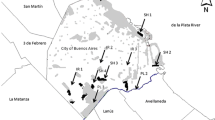Abstract
Long-term parasitological monitoring is important for observation of the emergence, establishment, and development of relations in parasite-host systems. The greatest achievement in helminthological investigations carried out in reserves is obtaining and analyzing long-term data that quantitatively and qualitatively characterize the interrelation of members in a biocenosis. The investigation of natural and anthropogenic processes in natural complexes and especially the identification of ecological mechanisms activated by different changes possess both scientific and practical value.
Similar content being viewed by others
References
Cameron, T.W.M., Studies on the Heterophyid Trematode Apophallus Venustus (Ransom, 1920) in Canada, Part I: Morphology and Taxonomy, Canad. Tourn. Science. Ottawa, Sect. D, 1936, vol. 14, pp. 59–68.
Ciurea, J., Les Vers Parasitaires de la Home, des Maniferes et des Oiseaux Provenant des Poisons du Danube et de la Mer Noire, Premier Memoire Trematodes Familie Hetetophyidae Odhner Avec un Essai de Classification des Trematodes de la Superfamilie Heterophyoidea Faust, Arch. Roumain. Pathol. Exper. Microbiol., 1933, no. 6, pp. 150–171.
Dubinin, V.B., Parasitofauna of Mouse-Like Rodents and Its Changes in the Volga Delta, Parazitol. Sbornik ZIN SSSR, Moscow, Leningrad: AN SSSR, 1953, vol. 15, pp. 252–302.
Ivanov, V.M., Trematodes Apophallus muehlingi and Rossicotrema donicum are Pathogens of Helminthiasis in Fish in the Volga Delta and North Caspian, Extended Abstract of Cand. Sci. (Biol.) Dissertation, Moscow, 1991, 20 p.
Ivanov, V.M., Monitoring, Structural Changes and Ecological Peculiarities of Trematoda Fauna of Vertebrates from the Volga Delta and North Caspian (Fauna, Taxonomy, Biology, Ecology and Pathogenic Value), Extended Abstract of Doctoral (Biol.) Dissertation, Moscow, 2003, 48 p.
Ivanov, V.M. and Semenova, N.N., Parasitological Consequences of Animals’ Introduction, in Ekologiya (Ecology), Moscow: Nauka, 2000, no. 4, pp. 307–309.
Ivashkin, V.M., Kontrimavichus, V.L., and Nazarova, N.S., Metody sbora i izucheniya gel’mintov nazemnykh mlekopitayushchikh (Methods of Collection and Investigation of Helminths of Land Mammals), Moscow: Nauka, 121 p.
Maksimov, A.A., Kharitonova, N.N., Kadenatsii, A.N., and Abashkin, S.A., Epizootii v populyatsiyakh ondatry v SSSR (Epizootics in Muskrat Populations in USSR), Novosibirsk: Nauka, 1975, 207 p.
Me Diarmid, A., Diseases of Free-Living Wild Animals, F. A. O. Agr. Stud. (Roma), 1962, no. 57, 119 p.
Niemi, D.R. and Masy, R.W., The Life Cycle and Investivity to Man of Apophallus donicus (Skrjabin et Lindtrop, 1919) (Trematoda: Herophyidae) in Oregon, Proc. Helminthol. Soc. Wash., 1974, vol. 41, no. 2, pp. 223–229.
Odening, K., Der Lebenszyklus des Trematoden Apophallus donicus in Berlin in Vorgleich zu A. muehlingi, Biol. Zentralbl. Bd., 1973, vol. 92, pp. 455–494.
Opredelitel’ gel’mintov gryzunov fauny SSSR. Tsestody i trematody (Classification of Helminths of Rodents of USSR Fauna, Cestodes and Trematodes), Moscow: Nauka, 1978, 232 p.
Opredelitel’ gel’mintov gryzunov fauny SSSR. Nematody i akantotsefaly (Classification of Helminths of Rodents of USSR Fauna), Moscow: Nauka, 1979, 272 p.
Parshina, O.Yu., Ivanov, V.M., and Semenova, N.N., Trematodes Changing Epidemic Status of the Volga Delta, in Bioraznoobrazie bespozvonochnykh zhivotnykh. Sb. Materialov II Vserossiiskoi shkoly — seminara s mezhdubarodnym uchastiem (Biodiversity of Invertebrates, Transactions of II All-Russian School-Seminar with International Participation), Tomsk: Del’taplan, 2007, pp. 186–189.
Skryabin, K.I., Metody polnykh gel’mintologicheskikh vskrytii pozvonochnykh, vklyuchaya cheloveka (Methods of Complete Helminthological Dissection Including Humans), Moscow: Izd. 1-go Moskovskogo Univ., 1928, 45 p.
Sudarikov, V.E., Freze, V.I., Ivanov, V.M., Semenova, N.N., and Lomakin, V.V., Regularities of Genesis of Invasion of Trematodes in the Volga River Delta and North Caspian, Sibirskaya zoologicheskaya konferentsiya, posvyashchennaya 60-letiyu Instituta sistematiki i ekologii zhivotnykh SO RAN. Tez. dokladov (Siberian Zoological Conference Devoted to the 60th Anniversary of the Institute of Taxonomy and Ecology of Animals, Siberian Branch of Russian Academy of Sciences, Abstract of Papers), Novosibirsk, 2004, pp. 405–406.
Shaikenov, B., Gel’minty gryzunov Kazakhstana (Helminths of Rodents of Kazakhstan), Alma-Ata: Nauka, 1981, 172 p.
Author information
Authors and Affiliations
Corresponding author
Additional information
Original Russian Text © V.M. Ivanov, A.P. Kalmykov, V.V. Fedorovich, N.N. Semenova, O.Yu. Parshina, 2011, published in Aridnye Ekosistemy, 2011, Vol. 17, No. 4(49), pp. 66–73.
Rights and permissions
About this article
Cite this article
Ivanov, V.M., Kalmykov, A.P., Fedorovich, V.V. et al. Structural changes of helminthofauna in rodents caused by introduction and settlement of animals in the Volga Delta. Arid Ecosyst 1, 246–250 (2011). https://doi.org/10.1134/S207909611104007X
Received:
Published:
Issue Date:
DOI: https://doi.org/10.1134/S207909611104007X




